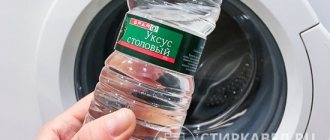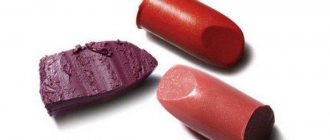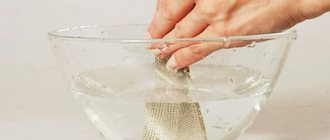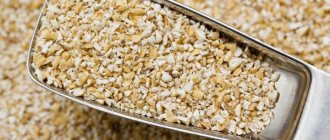A dishwasher makes life much easier by eliminating deposits on glasses, greasy films and stains, unpleasant odors and dirt from plates, pots and pans. Despite its intended purpose, the machine does not clean itself along with the dishes, but rather slowly accumulates the collected garbage.
Without timely maintenance, the dishwasher will stop doing its job, dirt will remain on the dishes, and the drain will begin to work too slowly. A number of problems will also appear, due to which it may seem that the dishwasher has done its job, but this is not the case.
To prevent such consequences, it is recommended to carry out comprehensive cleaning of the PMM.
About dirty dishwashers
Like any other appliance, a dishwasher is subject to contamination, and manufacturers recommend cleaning it at least once a month. Depending on the frequency of use, this can be done less often.
The degree and speed of dishwasher contamination depends on several factors:
- The machine runs once a day or more often;
- The door remains closed after washing. In this case, there is a risk of mold growing inside the device;
- Hard water without softening salt for dishwasher;
- Very dirty dishes: with food residues, burnt parts and congealed fat;
- Washing at low water temperature;
- Washing plastic or wooden utensils not intended for use in the machine.
There are also several signs that indicate that your dishwasher needs cleaning:
- Unpleasant odor inside;
- Remaining dirt or white streaks on dishes after washing in the machine;
- Remaining food inside the chamber;
- Plaque on the filter;
- The water begins to drain slower than usual.
If at least one of these signs is present, then you should think about the fact that it’s time to wash the car. Despite its purpose, a dishwasher (even from well-known brands such as Bosch, Indesit) is not capable of cleaning itself; a person must do this.
Rating of brands and manufacturers
Almost every manufacturer of dishwashers also produces salt and detergent compositions for them, or recommends directly in the instructions for the machine to use a salt version of a particular brand with a specific dosage.
Prices for sold salt formulations vary little by brand - if saving money is not a priority, then it is best to purchase branded preparations recommended by the manufacturer of the dishwashing equipment in the kitchen
It is difficult to create a comprehensive rating of dishwasher salts, taking into account many different parameters. A similar composition is almost pure sodium chloride (usually the mass fraction of NaCl in them is 99.5–99.7%). Inventing something special here is problematic.
According to the standards, the product in question should not contain additives, rinsing aids, impurities or detergents. If anything similar is included in the description of the composition, then this is not an active salt for the ion exchanger, but a regular dishwashing detergent in an automatic dishwasher such as “3 in 1”, “5 in 1”, “ALL in 1”, etc. . Such tablets and powders are placed in a completely different compartment in the dishwasher.
The best option for regenerating salt is large NaCl crystals. The finely ground powdered analogue is used up too quickly; it is better to avoid it in the store. You need to look for a salt product in the form of granules with a minimum size of 4–6 mm. Tablets are also good in this regard, but not every ion exchanger can contain them simultaneously in the required quantity.
First place was given to Finish Calgonit due to the almost complete absence of negative reviews from housewives for products under this brand. In terms of cost, this salt is in the middle price segment.
Finish Calgonit is distinguished by high quality NaCl purification and large granules, whose characteristics are more consistent with premium products
This manufacturer also has products designed for washing dishes. We talked more about the brand's products in this material.
2nd place – Sodasan
Sodasan is as good as Finish Calgonite in sodium chloride purity, but costs a little more.
The brand “Sodasan” (this is not only salt) is produced by the famous, which is the undoubted leader among manufacturers of household chemicals for a wide variety of purposes
3rd place – Somat
Somat is distinguished by high levels of salt purity and the absence of any impurities in it. However, the crystals in the packaging of this manufacturer are smaller than those of others.
The salt consumption for the Somat PMM is a little higher, and in price it is practically not inferior to the first two competitors
Final third place - Somat is a classic middling player.
In addition to salt, this manufacturer's product range includes highly effective tablet dishwashing detergents.
4th place – Eonite
Under the Eonit brand, there are two types of anti-scale salts on the market: regenerating NATURAL and CLEANVON.
The first product is positioned as made from natural raw materials, and the second – with 99.9% purification. But the naturalness of NaCl is a big question.
All such salt is produced using the same technology by evaporation. This is more of an advertising ploy from a specific manufacturer, aimed at gullible housewives, rather than some kind of innovation.
Moreover, the price of both options is closer to 100 rubles/1.5 kg. Fourth place for the presence of different products in the line and budget price.
5th place – Top House
Closes the top five in the Top House rating. These are the largest crystals among competitors, but the price is high. This salt lasts a long time in the ion exchanger.
If the dishwasher is used frequently and a lot of dishes are washed, then this is a great option. However, if you use the dishwasher infrequently, it is better to take a cheaper anti-scale product
In all cases, you will have to pay about 100–250 rubles for a 1.5 kg pack of salt. The price depends on the region, the seller and discount promotions.
If a cheaper product is offered under a different brand with a cost below 100 rubles, then you should take it with caution. Cheapness here is the first sign of too small granules or low purity of sodium chloride. As a result, you will pay less for salt, but it will quickly be used up or cause damage to the washing machine.
Cleaning dishwasher filters from dirt
Every dishwasher has two filters.
The first purifies the water in the unit from sand, small metal particles and impurities, the second purifies the water that drains from the dishwasher, preventing blockages in the drain.
As a rule, before loading dishes into the machine, they need to be cleaned of excess dirt and food debris by rinsing in warm water. But it's impossible to get rid of the excess in one go, and thorough washing renders the dishwasher useless.
Its filters are designed to process small particles; after restarting, they are washed off with water to the bottom of the washing chamber.
Clogged filters can lead to several problems at once:
- The car will become too noisy;
- The dishes will remain dirty;
- The water will drain too slowly;
- An unpleasant odor will appear.
Cleaning the Dishwasher Dust Filter
The drain cleaning filter is located at the bottom of the washing chamber and can be easily reached if you first remove all the dish baskets. Usually the filter is located under the water sprayer and is removed by unscrewing it clockwise.
The filter consists of several parts that are attached to each other. It is easy to separate them in order to wash each separately; the filter is put back together intuitively, as well as according to the instructions included with the dishwasher.
The filter should be washed under running water.
But if there is a strong coating left on it, then it is permissible to use chemical and natural detergents for cleaning:
- Laundry soap;
- Dishwashing liquid;
- Baking soda;
- Salt;
- Vinegar;
- Lemon acid.
You can use brushes and toothpicks to clean the filter grids.
Cleaning the dishwasher fill filter
The water supply valve filter clogs more slowly than a garbage filter, but this does not mean that you can forget about it. The degree of clogging directly depends on the hardness of the water; the harder the water, the more often it needs to be cleaned.
If a blockage forms in the valve filter, there is a risk of stopping the water supply.
In order to clean the filling filter, you need to turn off the power to the unit and stop the water supply. Then unscrew the inlet hose and remove the filter from its socket.
It is washed in the same way under water. Typically, cleaning it does not require the use of chemicals, as is the case with a cleaning filter.
How to remove scale - step by step
Cleaning a dishwasher with citric acid is no more difficult than cleaning a kettle or iron. Just keep in mind that the process is performed without dishes! Lemon juice combined with high temperatures is too aggressive for glass and metal cutlery: they will become dull and stained. In addition, no detergents are used during cleaning, which means that utensils left in the dishwasher will not be thoroughly washed.
Removing deposits is simple but long-lasting:
1. Remove baskets and dishes from the machine.
2. Remove the strainer, wash it in the sink with a brush and replace it.
3. Fill the detergent dispenser with citric acid and close it.
Tip: If you will be using a liquid product or need more powder than what comes in the dispenser, place the product in a heat-resistant, shallow glass dish and place it in the bottom of the dishwasher. Once the cycle begins, the bowl will overflow and the lemon will mix with the supplied water.
Be sure to check whether the rocker rotates freely - it should not touch the plate!
4. Turn on the program with the maximum heating temperature.
5. When the cycle ends, open the machine door and evaluate the result.
The internal hopper must be clean, free of white deposits, stains and deposits. Check the spray arm openings for any uncleaned residue.
If there are lime fragments left in the machine, repeat the cleaning process after 2-3 days.
6. Run a short cycle with 1/2 serving of powder or half a tablet.
This will wash away traces of scale and citric acid, and at the same time you can add dishes that are not very dirty - combine two useful things.
When finished, wipe the interior surfaces and parts of the dishwasher dry and leave it open to air.
Cleaning sprinklers from debris
A sprinkler can easily damage a dishwasher, because despite the fact that the water from the hose has already been cleared of large particles, it still contains microsand and calcium salt, which the filter allows through.
The spray system also depends on the water hardness, since at high levels the rubber seals on the rotating parts may weaken. You need to inspect them at least once a month in order to notice a malfunction in time.
To clean the sprayer you need to:
- Remove the basket with the rocker, including the lower level;
- Bend the latches and sprayer blades, pulling them upward;
- Inspect the seals;
- Rinse the blades, nozzles and components under normal water;
- Return everything to its original position.
Despite the fact that fasteners may differ from each other on different PMMs, they have the same assembly principle. For proper assembly, you must use the instructions included with the dishwasher.
Where else to apply
If you suddenly run out of rinse aid, our acid will come in handy again. Dilute it with water in a ratio of 1:3 and add to the appropriate dispenser.
Some inventive housewives mix lemon crystals into dishwashing powder. Supposedly it cleans better this way. Does this help? It all depends on the quantity; you need to check the proportions when mixing, as manufacturers of combined tablets do.
All detergents have an alkaline structure, due to which they clean dishes from grease. Acidity neutralizes degreasing, and in order for the powder to continue to wash, do not “overdo it” with additives.
Citric acid is a useful remedy. It is a good alternative to more expensive anti-scale agents, but it costs a penny, but the result is the same.
Manual cleaning process of dishwasher pump
The pump in a dishwasher is an important element of the system; it circulates water and cleaning fluid inside the machine.
The system is designed to save water when rinsing, soaking and washing dishes. If the quality of dishwashing has changed dramatically, the reason may lie in the pump being dirty, but it should be cleaned carefully.
The pump may be blocked by large pieces of food or foreign objects.
Before cleaning, you must unplug the dishwasher.
Then follow the simple instructions:
- Remove the upper and lower basket;
- Remove all filters;
- Scoop out all the water from the machine;
- Lift the pump cover using an object, grab the cover by the tab and pull it out completely;
- Check the impeller for integrity;
- If there are foreign objects, they must be carefully removed;
After checking, it is necessary to reassemble. It is also important to note that when cleaning the pump, you should never remove its protection.
How to clean the pump
It often happens that the water in the dishwasher stops draining. And the reason for this may be fatty deposits or food debris that got in with dirty dishes. But the pump can be cleaned. The actions will be as follows:
- Disconnect the machine from the network;
- Carefully remove the pump (to do this you need to unscrew all the fasteners);
- We remove the blockage. You can use a stick or pencil. Don't use your hands;
- We check the degree of rotation of the inner impeller;
- Wipe the surfaces with soapy water;
- We put the pump in place.
Important ! It is not always the housewife who will be able to figure out how to clean the pump on her own. Therefore, you should entrust the work to a professional.
How to clean a drain
A clogged drain is one of the reasons why your dishwasher stops working. After all, food particles can be really large and, together with fatty deposits, completely block the passage for water. But the drain system can be cleaned. We focus on the following:
- Prepare a container to drain the remaining water;
- Disconnect the hose from the sewer;
- We lower it into the container and turn on the water drain mode; Attention ! If the water flows with good pressure, then there is no valve in the drainage system itself and the blockage must be looked for elsewhere. If water drips, the drain is completely clogged.
- Disconnect the second end of the hose and rinse it under water pressure;
- Let's put everything in its place.
The process of cleaning a Bosh dishwasher will not take much time. Especially if you carry out periodic activities. Using special and home cleaning methods, the machine will remain clean and last for a long time.
Washing dishwasher baskets and racks
Baskets are mesh trays that hold dishes, but they can also accumulate grease, food debris and lint.
The principle of cleaning grids and baskets is practically no different from cleaning other parts. To do this, you can take a brush, soft microfiber cloths or a dishwashing sponge.
The baskets must first be removed from the dishwasher, then it is advisable to soak them in a detergent solution for a few minutes. Parts that cannot be removed from the machine will have to be cleaned and washed directly in it, moving them forward as much as possible.
Using a brush and sponges, you need to remove all remaining food and dirt, and then wipe the grates with a sponge on all sides.
For hard-to-reach places, an old toothbrush is suitable; you can use medium-hard bristles; they will not harm the dishwasher.
How to clean PMM
If you don’t know how to properly clean a machine, you can throw money away and waste an expensive product that was purchased after convincing advertising.
It is important not to leave it in the dishwasher for a long time, so as not to cause harm to the pipes, circulation pump, and the surface of the hopper. In this case, it is necessary to facilitate the interaction of substances with scale so that it is separated from the PMM parts and washed out of the machine completely.
When cleaning your dishwasher with commercial products, do not neglect the instructions on the label. This is necessary to maintain the exact dosage of the powder or gel, keep it in the system for a certain period of time and timely wash it out of the machine.
Cleaning requires one wash cycle lasting no more than 40 minutes.
Cleaning the dishwasher interior
The dishwasher chamber should be washed last; this is the final part of the entire procedure. But you should touch it only if there are no major contaminants on other parts of the machine.
Cleaning the PMM camera is carried out in several steps:
- You need to prepare a detergent; in this case, manufacturers recommend using special detergents for dishwashers, as they safely remove grease, mold and rust;
- In the instructions for the dishwasher, you need to find a section where the cleaning mode is described in detail, in which you need to add detergent and run the wash at the highest temperature.
As soon as the wash is finished, you can pour a glass of soda into the bottom, leave the car for a few hours and then wash off the remains. The dishwasher will now complete self-cleaning.
Eliminating scale, mold, grease and rust in the dishwasher
Removing scale, mold, grease and rust
If there are persistent contaminants inside the dishwasher, such as grease, scale, corrosion or mold, you cannot do without special cleaning compounds. You can buy professional products in the store and prepare them yourself.
Purchased funds
To descale your dishwasher, you can purchase one of the following cleaners:
- Finish Rinse . Japanese concentrated product that effectively removes scale. With this product you can easily clear a small blockage and say goodbye to unpleasant odors from the depths of the device. The manufacturer claims that the solution extends the service life of the unit.
- Finish Machine Cleaner . An effective two-layer product: blue liquid - against grease, white - against scale. The option when you need to clean your dishwasher quickly at home. The ease of use is captivating: unscrew the lid, turn the container upside down, and place it in the lower zone of the unit. To clean the car, it is enough to place the car wash at a temperature of 65°C.
- Filtero . The product is poured into the dispenser, depending on the degree of contamination, the machine is turned on for 1-1.5 hours, and the water is heated to the highest possible temperatures.
- Electrolux . If you need to clean your Electrolux dishwasher, purchase a branded product that will help remove small debris and grease layers. Electrolux powder, which is effective in removing scale, is also sold.
- "Antiscale" . Powder for degreasing surfaces, removing scale and limescale layers.
Do you need to know how to clean your washing machine with dishwashing tablets? Basically, all tablets, powders and gels work according to a similar scheme: drugs are loaded into an empty unit, work is started at a temperature of 45-90 ° C for a given time interval. To completely clean the equipment from “chemicals”, then turn on a short “idle” cycle.
Home Remedies
How to clean a dishwasher?
Recipes tested by housewives:
- Vinegar and soda against grease, rust, grease or mold. Here we will look at how to clean an Ariston dishwasher. Pour a glass of table vinegar into the dispenser, and sprinkle baking soda in an even thin layer on the bottom of the household appliance. Place the unit on the longest wash cycle. Once the machine has heated the water, press “Pause” and leave to soak for 30 minutes. Your dishwasher is clogged - how to clean the machine? If the car is very dirty, you can leave it overnight. Then remove from Pause and allow the device to complete the cycle.
- “2 in 1” soda tablets that remove grease, dirt and unpleasant odors. For a glass of baking soda - 15 drops of essential oil, 1-2 tbsp. spoons of hydrogen peroxide. Mix the ingredients into a homogeneous mass, reminiscent of wet fine sand. Roll balls from this mixture and place them on the bottom of the unit. To clean your dishwasher with a tablet, run the appliance on a long wash cycle.
- Lemon acid. On average, 150-200 g of product is required to clean one machine. Let's look at how to clean a dishwasher with citric acid. Turn on the washer at high temperatures, pause the device. Depending on the degree of contamination, leave to soak for 30 minutes or a couple of hours. Please note that citric acid must be used with great care - at high concentrations it is harmful to rubber parts.
Special cleaning products
To clean your dishwasher at home, it is best to choose a special product designed for this purpose.
First of all, the use of this product will prolong the operation of the machine, since the composition is selected in such a way that it will not harm the equipment and its parts that cannot be removed for washing.
The price of such products is usually not the lowest, so it is important to pay attention to the composition not only for the safety of the car, but also for your own safety. Unscrupulous manufacturers may replace the product with aggressive chemicals that are dangerous to human health.
It is best to take products that someone you know has tested or whose manufacturer you have already encountered.
Special tools are easy to use. They are poured into the powder compartment and clean the machine in wash mode.
Liquids from scale and grease
Often, special dishwasher detergents are already predisposed to removing grease and scale; their main task is to completely clean the dishwasher.
For this you can use the following brands:
- Henkel Somat Machine Cleaner;
- Milit;
- Reinex.
Operation and preventive recommendations
The optimal frequency of comprehensive care is once a month, and cleaning of the dishwasher drain and filtration system should be organized every week. To make general cleaning easier, you should use the following tips:
- It is better to lay out the dishes in accordance with the manufacturer's instructions. All heavy and large objects, as well as those with serious contamination, should be placed below; circulation is more intense in this area. Deep containers and glasses should be turned over so that water and detergent do not remain in them;
- food residues must be wiped off the dishes before loading with a paper napkin or towel;
- It is recommended to supplement washing tablets and powder with special salt containing softening components;
- At the end of the cycle, you need to pull out the filter mesh and remove the collected debris from it, and also check the compartment in which the cleaning chemicals are placed so that there are no residues in it.
During maintenance, it is recommended to use non-metallic tools and soft cloths to protect the interior surfaces from contact with hard fibers. Otherwise, any microdamage may cause the formation of rust.
To prevent a musty smell, you need to wipe the internal surfaces after each cycle with a dry cloth, and it is also advisable to ventilate the machine so that the condensation evaporates. It is recommended to run the device at least 3 times a week, as downtime contributes to the formation of limestone and blockages.
Cleaning with improvised means
Not everyone likes to use household chemicals to clean equipment and prefer to use other classic options that are no less effective at cleaning the dishwasher from dirt.
This can be a powder, solution, dishwashing detergent or special tablets.
Vinegar
This is a very aggressive substance and at first glance it seems that vinegar can clean everything. This is true, but you need to be careful when using vinegar, as it can have a negative effect on the rubber inside the dishwasher and on its parts.
If you use vinegar, then in small proportions and extremely rarely.
Borax
Sodium borate is a commonly used cleaning method.
The solution is mixed with plain water. You need to moisten the sponge in the resulting mixture and wipe the working cavities, seals and other parts with it.
The solution can also be poured into the powder compartment and turn on the machine in washing mode.
Lemon acid
This is a universal and least harmful composition.
The mixture will remove scale, grease, rust and mold, and the amount of citric acid determines the level of contamination of the machine.
For an average level of contamination, you will need 300 grams, which must be poured into the powder compartment. This amount of acid is enough to tidy up the dishwasher.
How many grams do you need
Citric acid is sold in liquid form and as crystalline powder. When descaling, it is more convenient to use crystals - they will remain in the detergent dispenser until the desired cycle begins. Almost all of the liquid substance will leak out and will not have the desired effect.
Lemon powder is cheaper: with the price of crystals starting from 30 rubles. for 100 gr. in a 100 ml bottle. pay more than 55 rubles.
How many grams are required depends on the general contamination of the device and the thickness of the scale on the heating element. In modern dishwashers, the heating element is hidden in the housing, and without disassembling the unit, you cannot see the layers of deposits. The following proportions will serve as a guide:
- If you descale regularly, or live in an area with soft water and the machine looks clean, then 50-80 g will be enough. (3-5 tablespoons);
- if cleaning has never been done, there is a whitish coating in the hopper, limescale “growths” on the holes of the rocker arms and tap water with a large number of impurities - increase the consumption of the product to 150-200 g.
Prevention of contamination to increase service life
There are a few simple tips that will reduce the risk of dishwasher failure and increase its service life:
- After each wash, you need to leave the door ajar so that the moisture leaves faster and does not provoke the appearance of mold;
- After use, it is advisable to wipe the rubber bands inside the machine with a dry cloth, and the outside of the doors with a damp cloth;
- For cleaning in the washing mode, it is recommended to use special products and extremely rarely resort to other methods, since if used frequently they can have the opposite effect and affect performance;
- Clean your dishwasher weekly.
By following the recommendations from the first days of use, the dishwasher will not only last longer, but will also not take up much time during the days allotted for cleaning it.
Daily care will make the process easier and eliminate the need to use aggressive chemicals. The equipment does not require maintenance if it is carried out in a timely manner.
Operating principle
The dishwasher has a built-in reservoir with ionized resin. When water passes through it, the positively charged magnesium and calcium ions are attracted to the negatively charged sodium ions in the resin. To restore the lack of sodium in the ion exchange tank, it is necessary to rinse it with sodium chloride water at the end of the washing cycle. After this action, the ion exchanger is ready to again replace calcium with sodium during the subsequent loading of dishes.
That is why manufacturers of dishwashing equipment use the term “regenerating salt” (regenerating). The chemical process helps soften the water, thereby allowing the liquid to enter the tank without harmful impurities. If you ignore the recommendations of dishwasher manufacturers and do not use salt, over time the ion exchanger will fail and the parts will become covered with scale. All this will lead to equipment failure.
How to eliminate the causes yourself
Each of the breakdown options has its own simple solutions, which you can try to cope with yourself. Before starting repairs, you must carefully read the instructions for the machine and unplug the power cord from the outlet. Then remove the drain hose from the sewer and lower it into a bucket. If liquid suddenly gushed out in a sharp stream, then the most likely cause of the blockage is a clogged sewer or drain. If water still remains in the dishwasher, you need to look for the cause further by first collecting it manually and draining the internal tank.
Kink in the drain hose. During general cleaning of the apartment and direct care of the unit itself, its location may temporarily change. Therefore, the drain hose can bend anywhere and prevent water from flowing freely. You need to carefully inspect it for correct installation and correct the position.
Sometimes the hose becomes clogged with mechanical debris (bones, solid food particles) and loses its capacity. Then you need to disconnect it from the dishwasher and remove it from the connection to the sewer and rinse it under strong water pressure.
Poor water pressure. If there is poor pressure in the city water supply system, then it will enter the device in insufficient quantities and can cause a general malfunction of the electronic module. The wash cycle will not start correctly and the sequence of commands may be incorrect.
Clogged sewer in the apartment. If the device has a common outlet with a sink and water does not drain well from there, then you need to try to eliminate the mechanical blockage using special chemicals such as “Mole” or a cable for cleaning the sewer system. Most often, the root cause of poor water drainage in such cases is pipes clogged with plugs of hair, congealed fat or food debris.
A blockage in the general sewer system in an apartment building or private building will also prevent the direct outflow of water. It’s very simple to understand this - not only the water from the kitchen appliances does not drain, but, in general, everything in the house.
Drain filter clogged. Almost always, users of household appliances neglect manufacturers' recommendations for operation. The device is not properly maintained and this leads to failure. When using a dishwasher, the manufacturer strongly recommends cleaning cutlery from any uneaten food particles before putting it in. Otherwise, they heavily clog the fine mesh of the internal filter and prevent the waste liquid from draining. This problem is quite easy to deal with. You just need to take out the removable filter, clean it under running water and install it back.
Clogged blades most often occur due to poor quality of city water. When it is very hard, the small outlet holes become clogged with limescale and the flow of water goes in the wrong place. It is necessary to remove the blades, clean them with a toothpick, rinse them under a strong stream and insert the impeller back.
Drain pump clogged. When the internal drain is clogged, water sits in the internal tank and does not drain through the drain hose. If all of the above measures do not help, then the cause may be the drain pump. You can find its location by carefully studying the instructions. You should unscrew the protective cover and try to rotate the pump blades with a stick or pencil. When movement is difficult, you should try to remove the foreign object and screw the pump back in.
Decoding the e25 code on the dishwasher display - read more in our article.
How to clean parts and remove blockages
To solve sewer problems, you can call a repairman or do it yourself. For example:
- clean the contaminated area with a thin brush on a wire;
- disconnect the siphon and rinse it with water;
- add special powder and use a plunger.
What to choose is up to you. You also need to clean the drain hose: under pressure from a tap or mechanically (using a brush).
You will have to devote more time to internal problems. Let's look at how to clean a clogged filter.
Drain filter
Before starting work, disconnect the PMM from the network and turn off the water supply. Proceed like this:
- Open the camera door.
- Pull out the lower dish basket.
- Unscrew the filter and metal mesh from the pan.
- Rinse under the tap. Additionally, you can use a soft brush and toothpick for particularly difficult stains.
Remove water from the container in the tray with a sponge. Remove the pump damper. Pull the cover to the side and then towards you. Additionally, you may need to unscrew the screws. Check the impeller for blockages. If everything is in order, then inspect the pump and its parts.
Drain pump
You need to disassemble the dishwasher to get to the pump. Remove all baskets from the chamber. Pull the car out into a free space and place it “on its back”. Then do this:
Unscrew the screws or unfasten the latches of the bottom cover (bottom). A float sensor can be attached to the back of the bottom. Carefully unscrew the mounting bolt and unfasten the wiring. Once you gain access to the circulation block, you will notice that the pump is attached to the side. Unscrew its screw. Disconnect the wiring plugs.
Additionally, you can inspect other parts, hoses, and pipes.
Spray
Everything is simple here:
- The lower rocker arm is located near the drain filter.
- Scroll it and remove it from its seat. On some models, you may need to press down on the latches.
- Rinse the part with water. Additionally, the injectors are cleaned with a toothpick.
Be sure to inspect the top sprayer and its openings. Sometimes scale accumulates in the holders to which the sprinkler is attached.
Intake filter
The mesh can be cleaned by disconnecting the inlet hose from the PMM body. If a part is clogged with scale, place it temporarily in water with the addition of citric acid. It is recommended to clean the mesh at least once every six months.
Conclusions and useful video on the topic
To visualize the scope of the upcoming cleaning, the features of removing and cleaning the internal elements of the dishwasher, we suggest that you familiarize yourself with a small selection of video tips from home craftsmen and experienced housewives.
Regular care and preventive cleaning of dishwasher systems:
As you can see, there is nothing difficult in caring for dishwashing equipment. But if the machine is not pampered with regular cleaning, its sparkling walls will quickly become covered with plaque.
Food debris will clog filters and spray nozzles, fungus will settle in the seal, and key parts will fail and require replacement. Don’t forget about your assistant or entrust her prevention to cleaning specialists.
Would you like to talk about how and with what means you care for your own dishwasher? Do you have a unique technique or interesting information that is worth sharing with site visitors? Please write comments in the block below and ask questions about the topic of the article.











